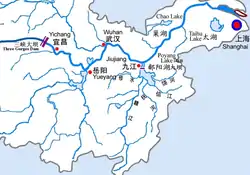Poyang Lake
Poyang Lake (traditional Chinese: 鄱陽湖; simplified Chinese: 鄱阳湖; pinyin: Póyáng Hú, Gan: Po-yong U), located in Jiangxi Province, is the largest freshwater lake in China.[4]
| Poyang Lake | |
|---|---|
 Satellite image of Lake Poyang | |
 Poyang Lake | |
| Location | Jiangxi, China |
| Coordinates | 29°05′N 116°17′E[1] |
| Primary inflows | 5 rivers, primarily the Gan and Xiu |
| Catchment area | 162,225 square kilometers (62,635 sq mi)[2] |
| Basin countries | China |
| Max. length | 170 kilometers (110 mi) |
| Max. width | 17 kilometers (11 mi) |
| Surface area | 3,210 square kilometers (1,240 sq mi)[1] |
| Average depth | 8.4 meters (28 ft)[1] |
| Max. depth | 25.1 meters (82 ft)[1] |
| Water volume | 25.2 cubic kilometers (6.0 cu mi)[1] |
| Residence time | 0.173 years[1] |
| Shore length1 | 1,200 kilometers (750 mi)[1] |
| Surface elevation | 16.5 meters (54 ft)[1] |
| Official name | Poyanghu |
| Designated | 31 March 1992 |
| Reference no. | 550[3] |
| 1 Shore length is not a well-defined measure. | |
The lake is fed by the Gan, Xin, and Xiu rivers, which connect to the Yangtze through a channel.
The area of Poyang Lake fluctuates dramatically between the wet and dry seasons, but in recent years the size of the lake has been decreasing overall. In a normal year the area of the lake averages 3,500 square kilometers (1,400 sq mi). In early 2012, due to drought, sand quarrying, and the practice of storing water at the Three Gorges Dam the area of the lake reached a low of about 200 square kilometers (77 sq mi).[5] The lake provides a habitat for half a million migratory birds[6] and is a favorite destination for birding.
During the winter, the lake becomes home to many migrating Siberian cranes, up to 90% of which spend the winter there.
Formation

Poyang Lake has also been called Pengli Lake (彭蠡澤) historically, but they are not the same. Before the Han Dynasty, the Yangtze followed a more northerly course through what is now Longgan Lake whilst Pengli Marsh formed the lower reaches of the Gan River. The area that is now Poyang Lake was a plain along the Gan River. Around 400 AD, the Yangtze River switched to a more southerly course, causing the Gan River to back up and form Lake Poyang. The backing up of the Gan River drowned Poyang County and Haihun County, forcing a mass migration to Wucheng Township in what is now Yongxiu County. Wucheng thus became one of the great ancient townships of Jiangxi Province. This migration gave birth to the phrase, "Drowning Haihun County gives rise to Wucheng Township" (Chinese: 淹了海昏縣,出了吳城鎭).
Lake Poyang reached its greatest size during the Tang Dynasty, when its area reached 6,000 square kilometers (2,300 sq mi).
Environmental issues

Loss of Wildlife
A fishing ban has been in place since 2002.
In 2007 fears were expressed that China's finless porpoise, locally known as the jiangzhu ("river pig"), a native of the lake along with other waters such as Dongting Lake, might follow the baiji, the Yangtze river dolphin, into extinction. Calls have been made for action to be taken to save the porpoise, of which there are about 1,400 left, with between 700 and 900 in the Yangtze, and another about 500 in Poyang and Dongting Lakes. 2007 population levels are less than half the 1997 levels, and the population is dropping at a rate of 7.3 percent per year.
Sand dredging has become a mainstay of local economic development in the last few years, and is an important source of revenue in the region that borders Poyang Lake. But at the same time, high-density dredging projects have been the principal cause of the death of the local wildlife population. Dredging makes the waters of the lake muddier, and the porpoises cannot see as far as they once could, and have to rely on their highly developed sonar systems to avoid obstacles and look for food. Large ships enter and leave the lake at the rate of two per minute and such a high density of shipping means the porpoises have difficulty hearing their food, and also cannot swim freely from one bank to the other.[7]
Furthermore, construction of Poyang Lake Dam is expected to cause devastating effects on the remaining porpoises.[8]
Shrinkage
Due to the Three Gorges Dam upriver on the Yangtze river, Poyang Lake can seasonally shrink and dry up.
In 2012, the lake nearly dried up completely. 200 square meters (2,200 sq ft) of land was underwater in October, while the lake is normally 3,500 square meters (38,000 sq ft) in area when full. In addition to the Three Gorges Dam, which must store water in its reservoir to be usable in winter, a drought was also blamed for the shrinkage.[5]
The Jiangxi local government has proposed to build the Poyang Lake Dam to maintain water levels in the lake, building a sluice wall across the connection between the lake and the Yangtze river. An environmental impact assessment is pending. Scientists, as well as environmental groups such as the World Wide Fund for Nature, have criticized the proposal, arguing that artificially engineering water levels in the lake will adversely affect wildlife diversity.[9]
In history
In 1363, the Battle of Lake Poyang took place there; the battle is claimed to be the largest naval battle in history.
References
- "Poyang Lake". World Lake Database. International Lake Environment Committee Foundation. 1999. Retrieved 6 January 2017.
- Ding, Duowen; Tan, Xueqing (2011). "Numerical Simulation of the Effects of the Urbanization on the Poyang Wetland". In Kenneth W. Potter, Donald K. Frevert (ed.). Watershed Management 2010. American Society of Civil Engineers. p. 444. ISBN 978-0-7844-1143-8.
- "Poyanghu". Ramsar Sites Information Service. Retrieved 25 April 2018.
- http://english.people.com.cn/200202/21/eng20020221_90777.shtml People's Daily Online "Spring Fishing Ban on China's Largest Freshwater Lake"
- Thibault, Harold (31 January 2012). "China's largest freshwater lake dries up". The Guardian. ISSN 0261-3077. Retrieved 9 November 2016.
- Detailed Data Lake Poyang-hu. Global Nature Fund.
- Kejia Z. (2007). Poyang Lake saving the finless porpoise. Chinadialogue.net. Retrieved on 28 September 2017
- Chen, S. (24 September 2017). "Water scheme threatens Yangtze River porpoises with extinction, scientist warns". South China Morning Post. Retrieved 29 December 2018.
- Ives, Mike (29 December 2016). "As China's Largest Freshwater Lake Shrinks, a Solution Faces Criticism". New York Times. Retrieved 29 December 2016.
External links
| Wikimedia Commons has media related to Poyang Lake. |